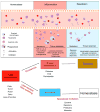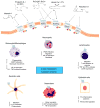Natural resolution of inflammation
- PMID: 23931059
- PMCID: PMC4022040
- DOI: 10.1111/prd.12034
Natural resolution of inflammation
Abstract
Inflammation is a protective response essential for maintaining human health and for fighting disease. As an active innate immune reaction to challenge, inflammation gives rise to clinical cardinal signs: rubor, calor, dolor, tumor and functio laesa. Termination of acute inflammation was previously recognized as a passive process; a natural decay of pro-inflammatory signals. We now understand that the natural resolution of inflammation involves well-integrated, active, biochemical programs that return tissues to homeostasis. This review focuses on recent advances in the understanding of the role of endogenous lipid mediators that modulate cellular fate and inflammation. Biosynthesis of eicosanoids and other lipids in exudates coincides with changes in the types of inflammatory cells. Resolution of inflammation is initiated by an active class switch in lipid mediators, such as classic prostaglandins and leukotrienes, to the production of proresolution mediators. Endogenous pro-resolving lipid mediators, including arachidonic acid-derived lipoxins, aspirin-triggered lipoxins, ω3-eicosapentaenoic acid-derived resolvins of the E-series, docosahexaenoic acid-derived resolvins of the D-series, protectins and maresins, are biosynthesized during the resolution phase of acute inflammation. Depending on the type of injury and the type of tissue, the initial cells that respond are polymorphonuclear leukocytes, monocytes/macrophages, epithelial cells or endothelial cells. The selective interaction of specific lipid mediators with G protein-coupled receptors expressed on innate immune cells (e.g. G protein-coupled receptor 32, lipoxin A4 receptor/formyl peptide receptor2, chemokine-like receptor 1, leukotriene B4 receptor type 1 and cabannoid receptor 2) induces cessation of leukocyte infiltration; vascular permeability/edema returns to normal with polymorphonuclear neutrophil death (mostly via apoptosis), the nonphlogistic infiltration of monocyte/macrophages and the removal (by macrophages) of apoptotic polymorphonuclear neutrophils, foreign agents (bacteria) and necrotic debris from the site. While an acute inflammatory response that is resolved in a timely manner prevents tissue injury, inadequate resolution and failure to return tissue to homeostasis results in neutrophil-mediated destruction and chronic inflammation. A better understanding of the complex mechanisms of lipid agonist mediators, cell targets and actions allows us to exploit and develop novel therapeutic strategies to treat human inflammatory diseases, including periodontal diseases.
© 2013 John Wiley & Sons A/S. Published by John Wiley & Sons Ltd.
Figures



References
-
- Aderem A, Ulevitch RJ. Toll-like receptors in the induction of the innate immune response. Nature. 2000;406:782–787. - PubMed
-
- Albert CM, Campos H, Stampfer MJ, Ridker PM, Manson JE, Willett WC, Ma J. Blood levels of long-chain n-3 fatty acids and the risk of sudden death. N Engl J Med. 2002;346:1113–1118. - PubMed
-
- Aliberti J, Hieny S, Reis e Sousa C, Serhan CN, Sher A. Lipoxin-mediated inhibition of IL-12 production by DCs: a mechanism for regulation of microbial immunity. Nat Immunol. 2002;3:76–82. - PubMed
-
- Aoki H, Hisada T, Ishizuka T, Utsugi M, Kawata T, Shimizu Y, Okajima F, Dobashi K, Mori M. Resolvin E1 dampens airway inflammation and hyperresponsiveness in a murine model of asthma. Biochem Biophys Res Commun. 2008;367:509–515. - PubMed
Publication types
MeSH terms
Substances
Grants and funding
LinkOut - more resources
Full Text Sources
Other Literature Sources
Research Materials

